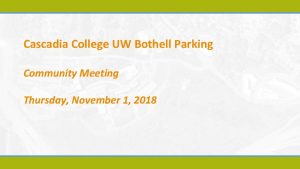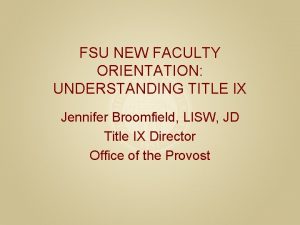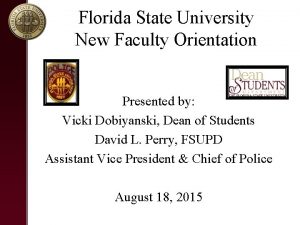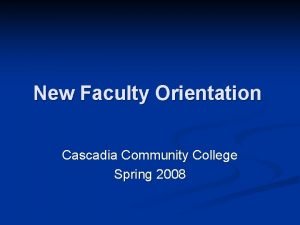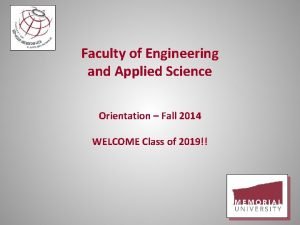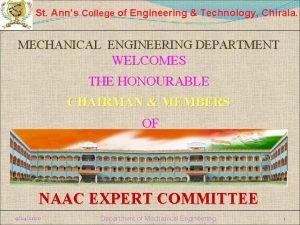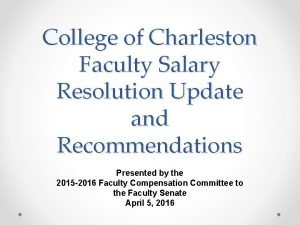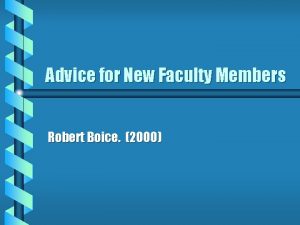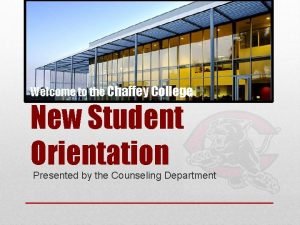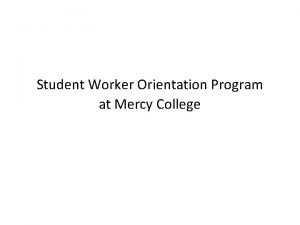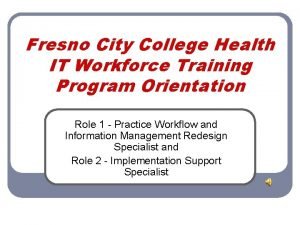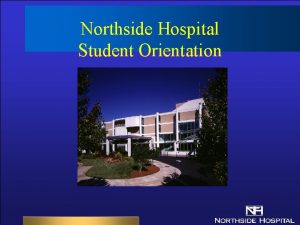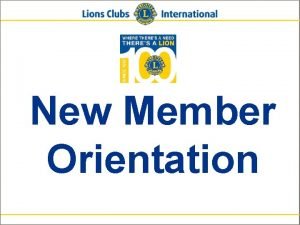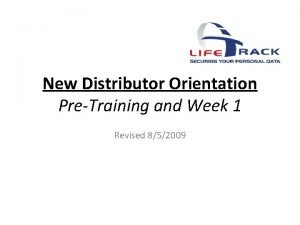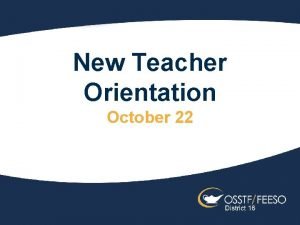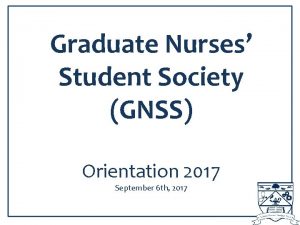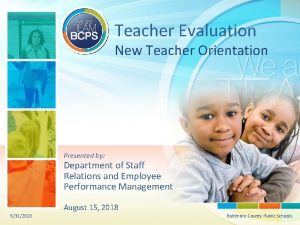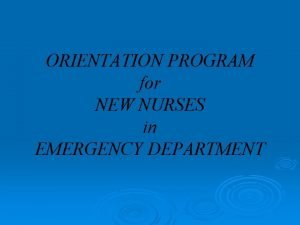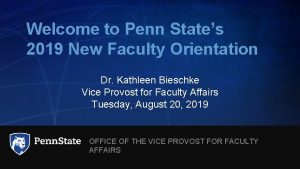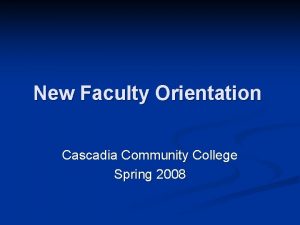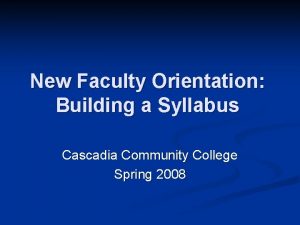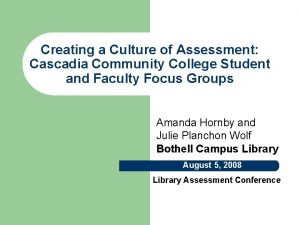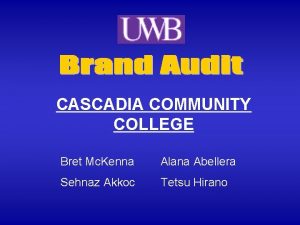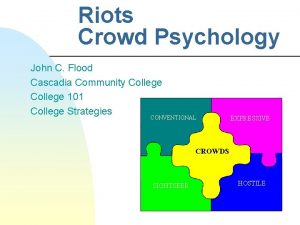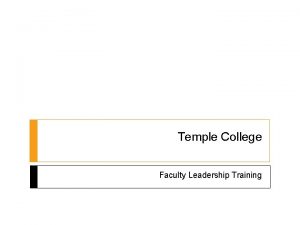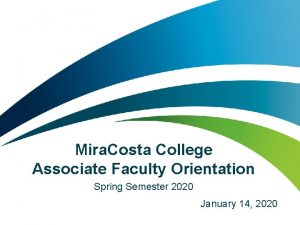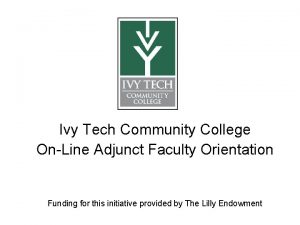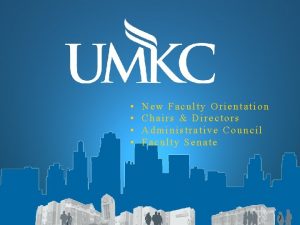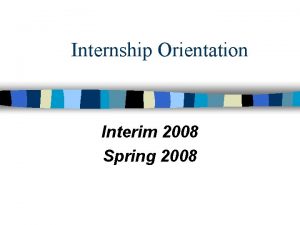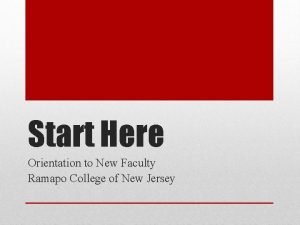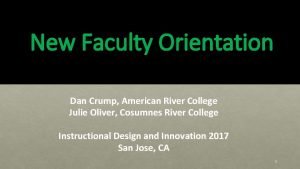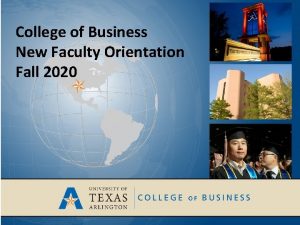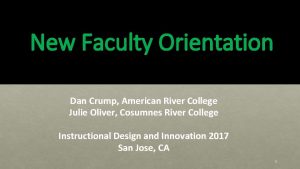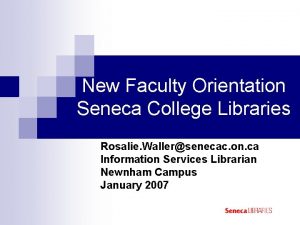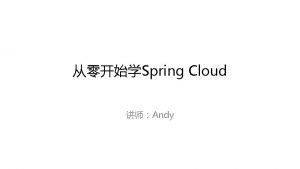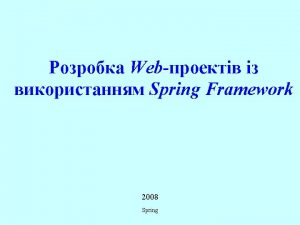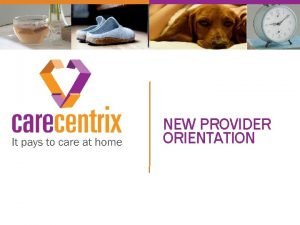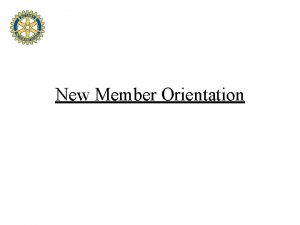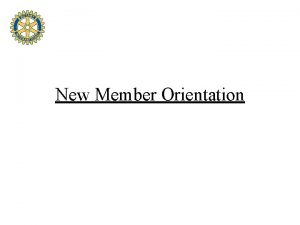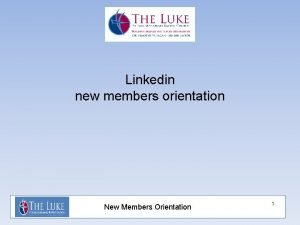New Faculty Orientation Cascadia Community College Spring 2008

























- Slides: 25

New Faculty Orientation Cascadia Community College Spring 2008

Session Overview 1. 2. Arriving at Cascadia Getting a Course Going 1. 2. 3. Keeping a Course Going 1. 2. 4. Managing Enrollment Building a Syllabus at Cascadia Using Technology at Cascadia Getting Support Growing at Cascadia

Orientation Outcomes Interact: Be welcomed to the Cascadia team and get “logged in. ” n Think: Begin to invent Cascadia courses. n Learn: Recognize some resources for teaching Cascadia courses. n Communicate: Get your questions answered. n

Arriving at Cascadia Who “We” Hope to Be

Introductions n Who are you? n What do you teach? n What’s one (brief) recent learning or teaching experience that left an impression on you?

Working for the WA SBCTC Longstanding commitment to access and success for a diverse student body n Early adoption of outcomes-based approach to higher education n Careful (and stringent) management of public resources n Uneven record of understanding part-time faculty needs n

Our Vision Cascadia Community College will be a community of lifelong learners pioneering innovative pathways to successful learning in a global context. community n innovative pathways n successful learning n global context n

Our Mission Cascadia is a community college whose caring culture supports creative, comprehensive, culturally rich, technologically advanced and learner-centered education that is environmentally sensitive, globally aware, and seamlessly linked with the community, area enterprise and other educational institutions.

Our Core Values As a learning organization, Cascadia continually strives to reach the highest levels of quality in its academic, student and administrative programs and services through continual analysis, assessment and improvement. Our quality indicators are our institutional core values. n n n n Community Diversity Access Success Learning Innovation Environmental Stewardship

Learning at Cascadia

The Cascadia Learning Model

Getting a Course Going

Using the Whole Campus Faces and places worth knowing • Sarah Leadley, Information Concierge • Joe Shelley, Media Guy

The Binder n n n Faculty Quick Links Address Book/Email Assessment/Grading Blackboard Bookstore Calendars Course/Instructor Evaluation Discipline Clusters Faculty Support Instructor Briefcase Library n n n n n Org Chart Public Information Rosters Student Responsibility Student Success Services Syllabus Teaching & Learning Academy Technology Voicemail Zocalo

Managing Enrollment: Nuts & Bolts n n n n n Getting a roster from Instructor Briefcase Adding and dropping students Managing a waitlist Keeping attendance Grading Being aware of placement and prerequisites Changing grades Advising Managing spaces

Building a Syllabus at Cascadia n n Creation. Syllabi match up with the guidelines and also serve teachers’ purposes. Distribution. The document goes to all students and also (electronically) to Faculty Support. Interpretation. Most faculty discuss this document in the first week; some create activities and assignments around it. Reflection. Syllabi are living documents. n n n We look at one another’s and learn how to teach differently We look at our own and understand how we contribute. The College looks at all syllabi to confirm its integrity.

Using Technology at Cascadia n Communication Technology n n Time Management Technology n n n Outlook Intranet/Zocalo Printers Outlook e. Web Portal Course Management Technology n n Attendance and Evaluation (Instructor Briefcase) Course Assessment (e. Portolio) Course Design (Shared Drives and Blackboard and Zocalo) Hybrid and Online Courses (Blackboard and Zocalo)

Keeping a Course Going

Everyday Teaching Needs (and Moral Support) 1. 2. 3. 4. The Faculty Support Staff (CC 1 154) can provide you with everything from markers to contract information; they are the first stop for all of us. Your Teaching and Learning Lead (TLL) is an experienced faculty in (or near) your area who can help you troubleshoot strategies. The TLA maintains a repository of teaching materials and host regular conversations about teaching. Your Dean can provide an institutional perspective and give you a sense for campus policy and resources (especially budget

Course and Instructor Assessment You can invite your TLL and other fulltime colleagues into your course to observe you at work. Their observation is non-evaluative and its aim is to help you see how you are teaching. n The TLA Director can arrange an SGID for you. n Every class at Cascadia completes an end -of-term evaluation. Faculty Support Staff schedule these in the last weeks of the term. n

Interactions with Students 1. 2. 3. Your TLL will be able to direct you to strategies and resources. The TLA can provide resources and schedule an SGID. Your Dean is your supervisor; when an issue becomes a concern, contact her to document the interaction and gain another perspective. You may determine that Cascadia’s Office for Disability Support Services and Counseling Services needs to be involved.

Concerns about Working Conditions 1. 2. 3. Your Dean is your direct supervisor, and she can guide you to common practices and conditions of hire. Human Resources executes your contract and manages payroll and benefits. The faculty union, the CCCFT, can guide you into the details of the contract and offer advice about the working environment. You are welcome to have a CCCFT “buddy” accompany you to any meeting at which working conditions and performance will be discussed.

Growing at Cascadia

Professional Development The TLA provides frequent workshops. n TLA Faculty Learning Communities offer more extended opportunities to develop new skills. n The College frequently stipends Associate Faculty to participate in initiatives and trainings. n The College provides funding for professional development activities through a Professional Development Committee. n

Review and Promotion The faculty contract lays out a process for the review of Associate Faculty and the promotion of Associate Faculty to Senior Associate Faculty. n Senior Associate Faculty can apply for multi-quarter commitments. n Associate Faculty are encouraged to apply for full-time positions as they become available. n
 Uw bothell parking permit
Uw bothell parking permit Fsu new faculty orientation
Fsu new faculty orientation Fsu orientation
Fsu orientation Cascadia capital
Cascadia capital 2008 2008
2008 2008 Andy fisher mun
Andy fisher mun Cast of spring, summer, fall, winter... and spring
Cast of spring, summer, fall, winter... and spring What are the months of spring
What are the months of spring Ethnocentric approach adalah
Ethnocentric approach adalah St ann's engineering college chirala faculty
St ann's engineering college chirala faculty College of charleston faculty salaries
College of charleston faculty salaries Advice for new faculty members
Advice for new faculty members My chaffey view
My chaffey view Mount mercy self service
Mount mercy self service Fresno city college training institute
Fresno city college training institute Northside hospital new hire orientation
Northside hospital new hire orientation Lions club member benefits
Lions club member benefits New distributor orientation program
New distributor orientation program New distributor orientation
New distributor orientation Famous toastmasters
Famous toastmasters New teacher orientation agenda
New teacher orientation agenda Gsu new student orientation
Gsu new student orientation Bcps teacher evaluation
Bcps teacher evaluation Emergency nursing orientation
Emergency nursing orientation Penn state factbook
Penn state factbook New member orientation in rotary
New member orientation in rotary
